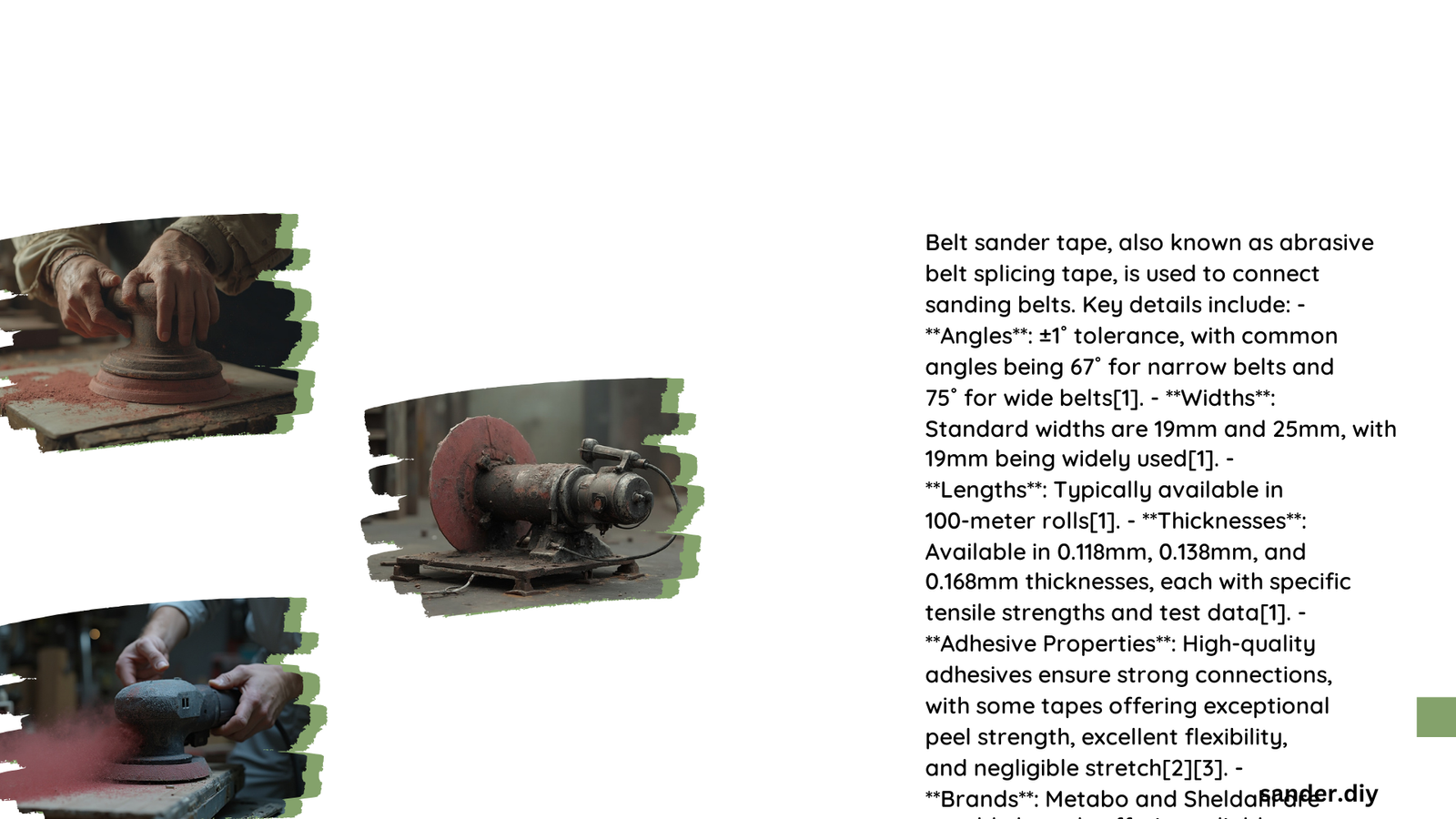Belt sander tape is a crucial component in woodworking and DIY projects, used to join the ends of sanding belts for continuous operation. It comes in various sizes, strengths, and types to suit different sanding applications. This adhesive tape ensures smooth, seamless joints that withstand the high-speed rotation and tension of belt sanders, making it indispensable for both professional woodworkers and hobbyists alike.
What Are the Standard Sizes of Belt Sander Tape?
Belt sander tape comes in various dimensions to accommodate different sanding belt sizes and applications:
- Width:
- Standard widths: 19mm and 25mm
-
19mm is the most commonly used width
-
Length:
-
Standard roll length: 100 meters
-
Thickness:
- Varies by type:
- AP9168: 0.168mm
- AP9138: 0.138mm
- AP9118: 0.118mm
For the actual sanding belts, dimensions can range significantly:
- Width: 0.5″ to 56″ (13 mm to 1422 mm)
- Length: 14″ to 582″ (356 mm to 1478 mm) or more
What Grit Levels Are Available for Belt Sander Tape?

Belt sander tape itself doesn’t have grit levels, but it’s used to join sanding belts of various grits. The grit levels for sanding belts follow the European FEPA standard:
- Coarse Grits (16, 24, 36, 40)
-
Use: Aggressive sanding, calibrating, and roughing
-
Medium Grits (50, 60, 80)
-
Use: Coarse sanding and brushing
-
Intermediate Grits (100, 120, 150)
-
Use: Intermediate sanding and finishing
-
Fine Grits (180, 220)
-
Use: Fine sanding and finishing
-
Micro Grits (240, 280, 320, etc.)
- Use: Typically for finer polishing operations, less common in belt sanders
What Are the Different Types of Belt Sander Tape?
While belt sander tape itself is primarily an adhesive product, it’s used with various types of sanding belts:
- Aluminum Oxide Belts
- Characteristics:
- High cut rate
- Durable
- Uses:
- Woodworking
- Metalworking
-
Grit Range: P36-P220
-
Silicon Carbide Belts
- Characteristics:
- Sharp cutting edges
-
Uses:
- Sanding metals
- Glass work
- Ceramic sanding
-
Ceramic Belts
- Characteristics:
- High stock removal rates
- Long belt life
- Uses:
- High-performance applications
- Heavy-duty sanding tasks
What Are the Key Characteristics of Belt Sander Tape?
Belt sander tape has several important specifications:
- Adhesive Strength
-
Strong enough to withstand high tensile forces during sanding
-
Tensile Strength
-
Varies by type:
- AP9168: 615 N/cm
- AP9138: 455 N/cm
- AP9118: 325 N/cm
-
Compatibility
-
Suitable for various belt materials:
- Cloth belts
- Paper belts
-
Joint Angles
- Narrow belts: Mostly 67°
- Wide belts: Mostly 75°
- Custom angles available on request
How to Choose the Right Belt Sander Tape?
Selecting the appropriate belt sander tape involves considering several factors:
- Belt Size
- Match the tape width to your sanding belt width
-
Consider the length of your sanding belt for proper joint angle
-
Application
- Heavy-duty sanding may require stronger tape (e.g., AP9168)
-
Lighter applications can use thinner tape (e.g., AP9118)
-
Belt Material
-
Ensure the tape is compatible with your sanding belt material (cloth or paper)
-
Joint Angle
- Use 67° for narrow belts
- Use 75° for wide belts
-
Consider custom angles for specific needs
-
Tensile Strength Requirements
- Match the tape’s tensile strength to your sanding application’s demands
What Are the Best Practices for Using Belt Sander Tape?
To ensure optimal performance and longevity of your sanding belts:
- Clean Surface
-
Ensure the belt ends are clean and free from dust before applying tape
-
Proper Alignment
-
Align the belt ends carefully to avoid unevenness
-
Correct Angle
-
Cut the joint at the recommended angle (67° or 75°) for your belt width
-
Even Pressure
-
Apply even pressure when adhering the tape to ensure a strong bond
-
Curing Time
-
Allow the joint to cure for the recommended time before use
-
Regular Inspection
- Check the joint periodically for signs of wear or separation
What Are Common Mistakes to Avoid with Belt Sander Tape?
- Using Wrong Size
-
Mismatch between tape width and belt width can lead to poor adhesion
-
Incorrect Joint Angle
-
Improper angle can cause premature joint failure
-
Dirty Surfaces
-
Applying tape to dusty or oily surfaces reduces adhesion strength
-
Insufficient Pressure
-
Not applying enough pressure during tape application can result in weak joints
-
Immediate Use
-
Using the belt immediately without allowing proper curing time can weaken the joint
-
Ignoring Wear Signs
- Failing to replace the belt when the joint shows signs of wear can lead to sudden failures
By understanding these aspects of belt sander tape, you can ensure better performance, longer belt life, and safer operation of your belt sander. Always follow manufacturer recommendations for best results in your woodworking or DIY projects.
References:
1. https://www.ad-adhesive.com/sanding-belts-splicing-tape/
2. https://www.mirka.com/SharePoint/mirkausa/marketing/Documentation/LI-WF004_Belts.pdf
3. https://www.abracom.es/en/blog/post/135-know-everything-about-your-belt-sander.html
